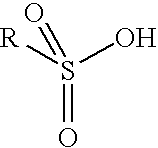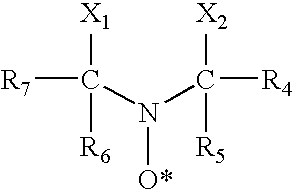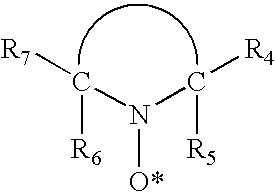Aromatic sulfonic acids, amines, and nitrophenols in combination with nitroxyl radical-containing compounds or C-nitrosanilines as polymerization inhibitors
a technology of aromatic sulfonic acids and aromatic sulfonic acids, which is applied in the direction of other chemical processes, organic chemistry, chemistry apparatus and processes, etc., can solve the problems of undesired polymerization of ethylenically unsaturated monomers, loss of monomers, and reduced yield, and achieves superb inhibitory and retarder capabilities, high efficiency and low cos
- Summary
- Abstract
- Description
- Claims
- Application Information
AI Technical Summary
Benefits of technology
Problems solved by technology
Method used
Image
Examples
example 1
[0135] The styrene inhibitor and retarder properties of the claimed combinations were tested in a Continuous Dynamic Reboiler Test monitoring the polymer formation with UV spectrophotometry. According to this test, the inhibitor is added to styrene monomer from which tert-butylcatechol (TBC) is previously removed by distillation. A quantity of 180 grams of this styrene is loaded into a flask, which is immersed into an oil bath. The temperature of styrene is usually 116° C. During the test, a fresh feed is charged into the flask at the rate of three grams / minute and, at the same time, the material from the flask is discharged at the same rate. The steady stage is continued until equilibrium. For the feed shut off stage, the charging and discharging are discontinued. Samples are taken every hour at the steady stage and every five to ten minutes at feed shut off.
[0136] The Continuous Dynamic Reboiler Test of the combination of 4-oxo-TEMPO / DBSA / NMP / DNBP at concentrations of 100 ppm / 100...
example 2
[0137] The Continuous Dynamic Reboiler Test of the combination of 4-oxo-TEMPO / DBSA / NMP / DNBP at concentrations of 100 ppm / 250 ppm / 75 ppm / 250 ppm, respectively, resulted in 0.0004% polymer in five hours steady stage and 0.157% polymer after two hours feed shut off.
example 3
[0138] The Continuous Dynamic Reboiler Test of 4-nitroso-N-(1,4-dimethylpentyl)-aniline / DBSA / NMP / DNBP at concentrations of 100 ppm / 250 ppm / 75 ppm / 250 ppm, respectively, resulted in 0.002% polymer in five hours steady stage and 0.007% polymer after two hours feed shut off.
PUM
 Login to View More
Login to View More Abstract
Description
Claims
Application Information
 Login to View More
Login to View More - R&D
- Intellectual Property
- Life Sciences
- Materials
- Tech Scout
- Unparalleled Data Quality
- Higher Quality Content
- 60% Fewer Hallucinations
Browse by: Latest US Patents, China's latest patents, Technical Efficacy Thesaurus, Application Domain, Technology Topic, Popular Technical Reports.
© 2025 PatSnap. All rights reserved.Legal|Privacy policy|Modern Slavery Act Transparency Statement|Sitemap|About US| Contact US: help@patsnap.com



